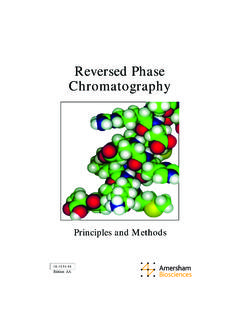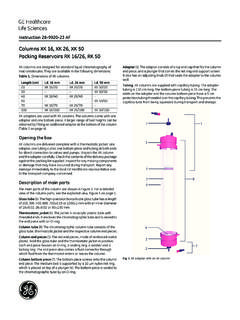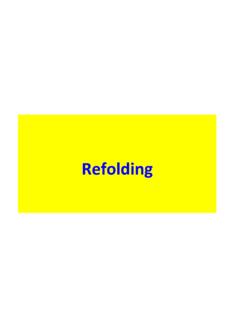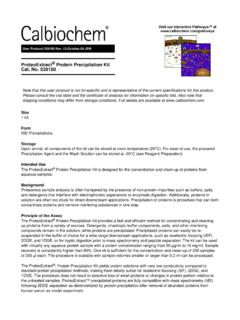Transcription of Application Note 11-0035-48 AA Multimodal media …
1 GE HealthcareApplication Note 11-0035-48 AA Multimodal mediaOptimizing elution conditions on Capto MMC using Design of ExperimentsAbstractThe Multimodal ligand of Capto MMC generally requires elution conditions that diff er from those used with traditional ion exchangers. This Application note describes how Design of Experiments (DoE) can be used to optimize elution conditions and thus recovery of a target protein. The results are summarized as follows: The eff ect of quantitative design factors , such as concentration of eluting salt , pH and ionic strength of the buff er, correlated positively with the recovery of the target protein. The qualitative factor, type of salt , also aff ected recovery. The use of DoE proved to be an effi cient way of investigating the eff ect of several parameters on target protein recovery. Furthermore, DoE revealed a curvature eff ect that could have been overlooked if multivariate analysis had not been MMC has a ligand with Multimodal functionality (Figure 1).
2 This means that diff erent types of interactions, such as ionic interactions, hydrogen bonding and hydrophobic interactions, are possible. The design of the ligand enables binding of proteins at high conductivity, however, it does limit elution using only increasing salt concentration. Thus a diff erent elution protocol has to be used compared to traditional ion , Capto MMC requires an increase in both pH and salt concentration for eff ective elution of bound protein. Additionally, the ionic strength of the buff er and the type of salt will also aff ect elution. Elution conditions for Capto MMC were investigated by measuring the recovery of bovine serum albumin (BSA) in an elution volume corresponding to 3 column volumes as a function of four diff erent parameters: salt concentration, type of salt , buff er ionic strength and 1. The Multimodal ligand of Capto support(matrix)2 11-0035-48 AAMaterial and methodsFrontal analysis Chromatography system: KTAexplorer 10 Column: Tricorn 5/100 Protein: BSAL oading buff er: 50 mM sodium acetate, 250 mM NaCl, pH (30 mS/cm)Loading concentration: 4 mg/mlAmount loaded: 40 mg BSAE lution buff er: see DoE belowFlow velocity: 600 cm/h (1 min residence time)Design of ExperimentsThe DoE setup was as follows:Factors:Responses:Salt , , MRecovery in elution volumes corresponding to 3 column volumes (CVs)Salt typeNaCl or NH4 ClBuff er ionic strength (BIS)* MpH , , * Calculated from the Henderson-Hasselbalch equation without correction for pKa shifts at diff erent ionic strengths.
3 The buff ers used were sodium malonate (pH and pH ) and sodium phosphate (pH ),The design was a full factorial design in multiple levels in order to resolve main, interaction and an observed curvature eff ect [1]. The software used for the design and evaluation was MODDE (Umetrics AB).Results and discussionAll of the tested factors aff ected recovery of BSA as shown by the coeffi cient plot (Figure 2).All of the main factors correlated positively with the recovery of BSA, indicating that an increase in any or all of the factors - pH, salt concentration or buff er ionic strength (BIS) - improves recovery. Although no interaction eff ects were identifi ed a curvature eff ect was observed, suggesting that recovery will decrease if the ionic strength of the buff er is above M. In the DoE, the eff ect of salt type was also investigated. NaCl and NH4Cl were studied, but the Hofmeister series can be consulted for choice of eluting salt [2]. The response surface plots for the recovery of BSA illustrate the results (Figure 3).
4 Full recovery was obtained under diff erent conditions . The highest pH ( ) allowed for the greatest variation in salt concentration and buff er ionic strength. Under these conditions NH4Cl gave better recovery than NaCl. Fig 2. Coeffi cient plot for the model of Conc NaClNH4 ClBIS*BIS11-0035-48 AA 3 Fig 3. Response surface plots for the recovery of BSA. Recovery is plotted as a function of salt concentration and buff er ionic strength (BIS) for two diff erent salts. Labels correspond to recovery in percent .NH4 ClNaClpH = = = Conc204060801002040608010020406080100406 0801002040608001030507090 Figure 3 illustrates the optimum values for the selected parameters in the DoE required to achieve full recovery. Buff er ionic strength should be about M at pH , which was the highest pH tested in this study.
5 Salt concentration is dependent on the type of salt used; in this DoE, NH4Cl gave a better recovery than NaCl at lower salt concentrations. For NH4Cl, full protein recovery was achieved when the salt concentration ranged from about M and upwards and the buff er ionic strength was M at pH It is possible to obtain full recovery at a lower pH with NH4Cl, but it should be noted that the salt concentration range narrows with decreasing response surface plots also show that full protein recovery is possible when elution is performed with NaCl, but only at the highest pH tested (pH ). However, the salt concentration range is narrower for NaCl than for NH4Cl. For NaCl, full protein recovery is achievable at a salt concentration of M and above when buff er ionic strength is M at pH this DoE, the eff ects of selected parameters on the recovery of a pure protein were investigated. In a real feed Application , other factors such as purity and removal of certain contaminants will need to be considered.
6 As proteins/contaminants have diff erent elution characteristics under diff erent conditions , DoE may be used to optimize the purity of the target protein or removal of certain Both a change in pH and an increase in salt concentration were needed to maximize recovery of the target protein. The lyotropic [2] character of the eluting salt infl uenced recovery elution with NH4Cl gave a higher recovery than elution with NaCl. A high buff er ionic strength also facilitated recovery through a more rapid change of pH during elution and possibly through the lyotropic eff ect of the buff er salt . In this study we have shown that DoE is a useful tool for scouting the best elution conditions on Capto MMC. DoE is benefi cial in that it can reveal interactions and quadratic eff ects* that may otherwise go unnoticed. DoE can be preferentially applied for optimizing elution conditions in real feed applications where more responses, e. g., purity and concentration of major impurities are relevant for the DoE experiments were performed on Tricorn 5/100 is most conveniently performed on prepacked HiTrap columns as they save both sample and time.
7 * The quadratic eff ect/term is used to quantify deviations from linearity in the 1. Box, G. E. P., Hunter, W. G., and Hunter, S. Statistics for Experimenters, John Wiley & Sons, Inc., New York (1978).2. Melander, W., and Horv th, C. Salt eff ects on hydrophobic interactions in precipitation and chromatography of proteins: an interpretation of the lyotropic series. Arch. Biochem. Biophys. 183 200-215 (1977). KTAexplorer, Capto, HiTrap, Tricorn are trademarks of GE Healthcare Ltd, a General Electric Company. GE tagline and GE Monogram are trademarks of General Electric goods and services are sold subject to the terms and conditions of sale of the company within GE Healthcare which supplies them. GE Healthcare reserves the right , subject to any regulatory and contractual approval, if required, to make changes in specifi cations and features shown herein, or discontinue the product described at any time without notice or obligation. 2005 General Electric Company All rights Biosciences AB, a General Electric Company going to market as GE Healthcare Amersham Biosciences ABBj rkgatan 30, 751 84 Uppsala, SwedenGE Healthcare Amersham Biosciences Europe GmbHMunzinger Strasse 9, D-79111 Freiburg, GermanyGE Healthcare Amersham Biosciences UK LtdAmersham Place, Little Chalfont , Buckinghamshire, HP7 9NA, UKGE Healthcare Amersham Biosciences Corp800 Centennial Avenue, Box 1327, Piscataway, NJ 08855-1327, USAGE Healthcare Amersham Biosciences KKSanken Bldg.
8 3-25-1, Hyakunincho, Shinjuku-ku, Tokyo 169-0073, HealthcareAmersham Biosciences ABBj rkgatan 30751 84 UppsalaSwedenAsia Pacifi c Tel: +852 2811 8693 Fax: +852 2811 5251 Australasia Tel: + 61 2 9899 0999 Fax: +61 2 9899 7511 Austria Tel: 01/57606-1619 Fax: 01/57606-1627 Belgium Tel: 0800 73 888 Fax: 03 272 1637 Canada Tel: 800 463 5800 Fax: 800 567 1008 Central, East , & South East Europe Tel: +43 1 982 3826 Fax: +43 1 985 8327 Denmark Tel: 45 16 2400 Fax: 45 16 2424 Finland & Baltics Tel: +358 (0)9 512 39 40 Fax: +358 (0)9 512 39 439 France Tel: 01 69 35 67 00 Fax: 01 69 41 96 77 Germany Tel: 0761/4903-490 Fax: 0761/4903-405 Italy Tel: 02 27322 1 Fax: 02 27302 212 Japan Tel: +81 3 5331 9336 Fax: +81 3 5331 9370 Latin America Tel: +55 11 3933 7300 Fax: +55 11 3933 7304 Middle East & Africa Tel: +30 210 9600 687 Fax: +30 210 9600 693 Netherlands Tel: 0165 580 410 Fax: 0165 580 401 Norway Tel: 815 65 555 Fax: 815 65 666 Portugal Tel: 21 417 7035 Fax: 21 417 3184 Russia & other & Tel: +7 (095) 232 0250 Fax: +7 (095) 230 6377 South East Asia Tel: 60 3 8024 2080 Fax: 60 3 8024 2090 Spain Tel: 93 594 49 50 Fax: 93 594 49 55 Sweden Tel: 018 612 1900 Fax: 018 612 1910 Switzerland Tel: 0848 8028 12 Fax: 0848 8028 13 UK Tel: 0800 616928 Fax: 0800 616927 USA Tel: 800 526 3593 Fax: 877 295 810211-0035-48 AAimagination at work









